Physicist: A normal rainbow is created when light enters a water droplet, bounces once off of the far side, and comes back out.
Diamond “droplets” however don’t make rainbows. In order to get a rainbow that exists, and isn’t in a tiny ring right around the sun (where it’s drowned out), the light has to bounce three times inside the droplet. By then it’s so dim that it’s unlikely anyone could see it. But if you could: it would form an arc about 50° from the “anti-solar direction” (the direction exactly opposite the sun; where your shadow is). For comparison, an ordinary rainbow is an arc about 40° around the anti-solar direction. If it doesn’t make plenty of sense why a rainbow is angle-dependent, why not swing by the first rainbow post?
You can figure out where rainbows should be by thinking about how light bounces in a sphere and applying “Snell’s law” (named after the horrifically named “Willebrord Snellius“). Then you can figure out what direction the light will ultimately go by adding up how much it turns from each interaction.
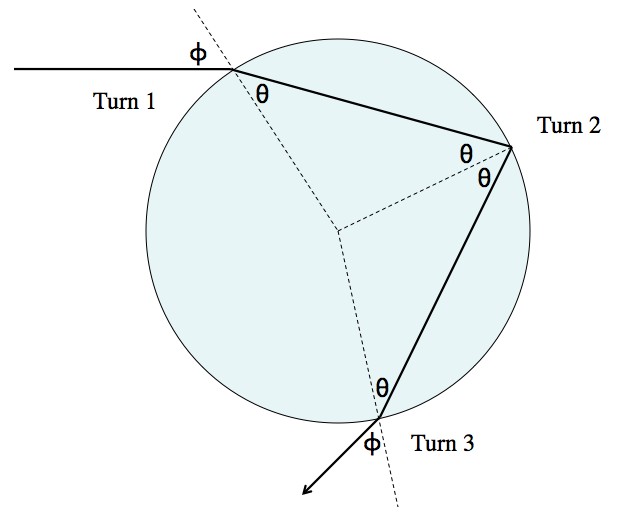
The set-up for a single-reflection rainbow. The light turns (in the same direction) three times: when entering, reflecting, and leaving.
Turn 1: When light enters the droplet it turns because of “refraction“. The exact amount is given by Snell’s gross-sounding law. If the index of refraction of the air is NA and the index of refraction of the water is NW, then: . It so happens that NA = 1 (well… 1.0003) and NW ≈ 1.3. NW is slightly different for different colors, which is ultimately what gives rise to rainbows. It takes a minute or two of pondering, but the light beam will turn to the right by an angle of
. First, imagine that
is zero, so the beam is pointing straight at the center of the drop. That’s a turn of angle
(by opposite angles). Now increase
and the amount of the turn decreases.
.
Turn 2: Since the radius of the droplet is fixed, the path of the light and the radial lines form an isosceles triangle. There’s another ! Since the incoming and reflected angles have to be the same you get one more
. If the beam were to have come straight back on itself that would’ve been a turn of 180°. But it falls short of that by
. So, the second turn is to the right again by an angle of
. If there are R reflections then the total turning angle will be
.
Turn 3: Snell’s did-you-sneeze-or-are-we-talking-about-optics law works the same way forward and backward. That is; the angles are the same going in or coming out. So, turn 3 is also by an angle of .
The total angle, A, is the sum of the three turns: . Snell’s law can then be used to solve for
:
So, the total turning angle is:
And allowing R reflections:
, by the way, mostly just describes where on the drop the light initially hits. In a second there’ll be a colorful graph that doesn’t make much sense. So consider this:
If a beam turns 180°, it’ll come right back at you. If it turns 120° it’ll form a 60° arc, and if it turns 240° it’ll still form a 60° arc. That’s a little confusing, so when you want to figure out how big a rainbow will be, quickly draw a picture to see what kind of angle the rainbow will make around the solar direction (toward the sun) or anti-solar direction (away).
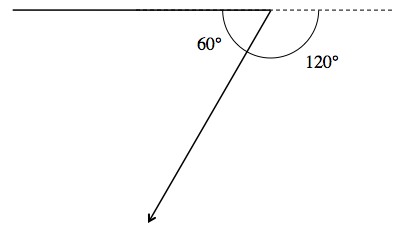
Whatever the total turn, just ask "how close is this to coming back or continuing forward?" In this picture a rainbow is made by light that turns 120°, so you can expect it to apear in a 60° arc around the anti-solar direction. 350° gives a 10° arc around the sun, 200° is a 20° arc around the anti-solar direction, ... Ordinary rainbows are created by light that turns 140° (picture below), and they appear in a 40° arc around the anti-solar direction.
Now check this out!
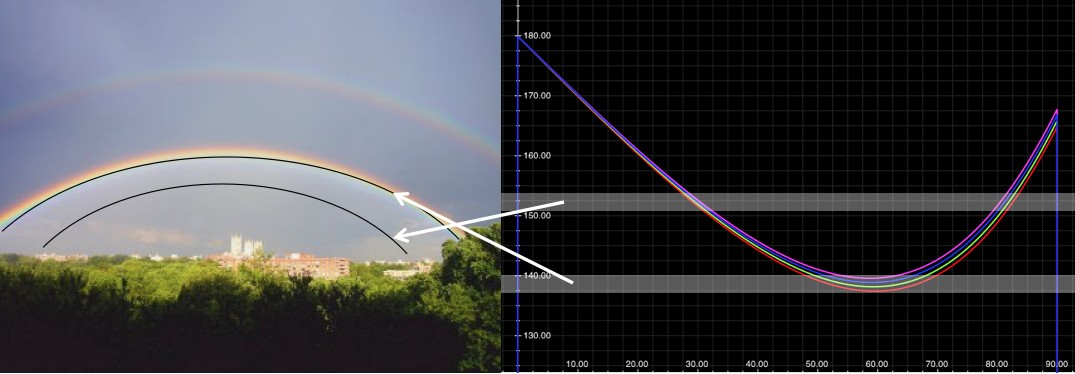
(click to enlarge) Different colors have different minimum turning angles. Red can turn as little as 138°, but the other colors all turn more. So at 138° you can only see red. At 140° all the colors are present, but purple is the most common. Inside the rainbow, between 140° and 180°, there's a fairly even mix of colors so you see white.
The index of diffraction is different for different materials, but it also changes for different colors of light (different frequencies). For water you can find them here. By graphing the total turning angle (vertical axis) vs. (horizontal axis) for several colors you can immediately see at what angle the rainbow will show up. In the graph above the red curve bottoms out lower than the other colors, so at 138° you’ll find red and nothing else. A little higher and you have mostly greens and not much else.
To see this, enlarge the picture above, get a pencil, and, holding it level, move it up the graph. You’ll notice that at various angles one color will be in contact with the top of the pencil for a far greater range than the other colors. Hence, at that angle a particular color will be far more common than the others.
In general, in these graphs, a rainbow will show up whenever there’s a minimum (for a maximum you’d need a really weird material that doesn’t follow Snell’s law). So, without graphing lots of colors, you can still spot the rainbow-angle where the curve hits a minimum.
So, here’s the curve for water turning-angle, alongside the curve for diamond (which has an index of refraction of about 2.4, but that depends on color too):
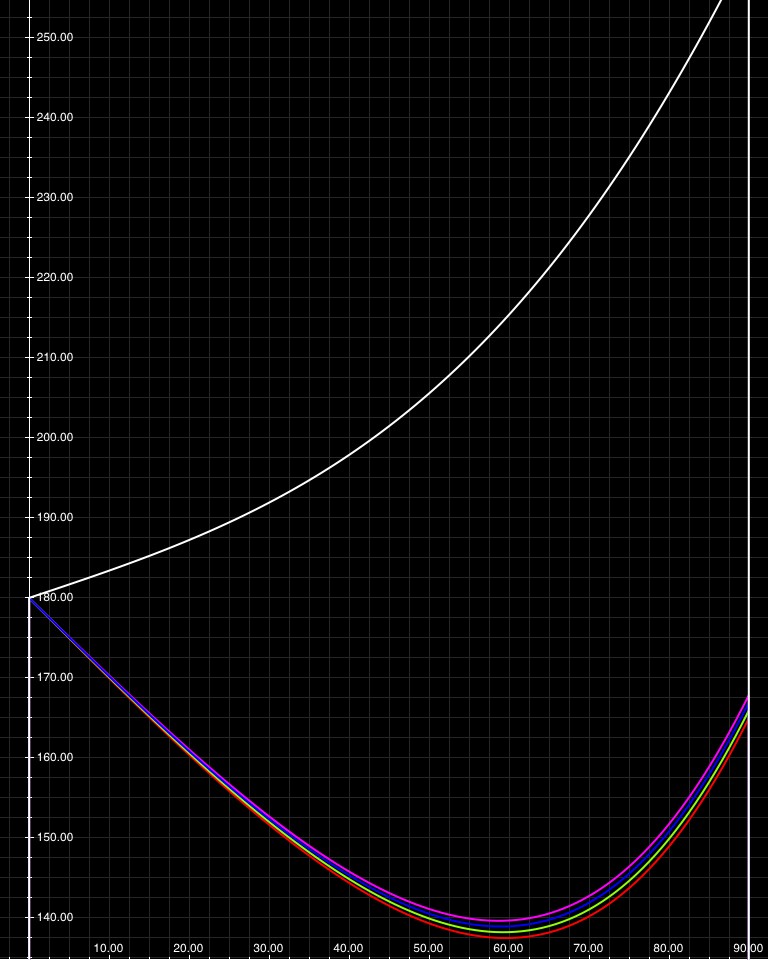
The angles that diamond droplets redirect light (white) and the angles that water redirects light. Since the diamond curve has no minimum, there's no angle where any color is strongly favored the way it is in water. For 1 reflection all of these curves will start at 180°, because light that hits the drop straight on (see top picture in this post) bounces once and comes right back out.
So: case closed. No diamond rainbows. But what about secondary rainbows?
You can bounce more than once inside of the droplet before coming out. Each time a beam of light hits the side of the droplet most of the light exits but some of it is reflected back in. One reflection gives you the standard rainbow, but two reflections gives you a second rainbow (hence: double rainbows).
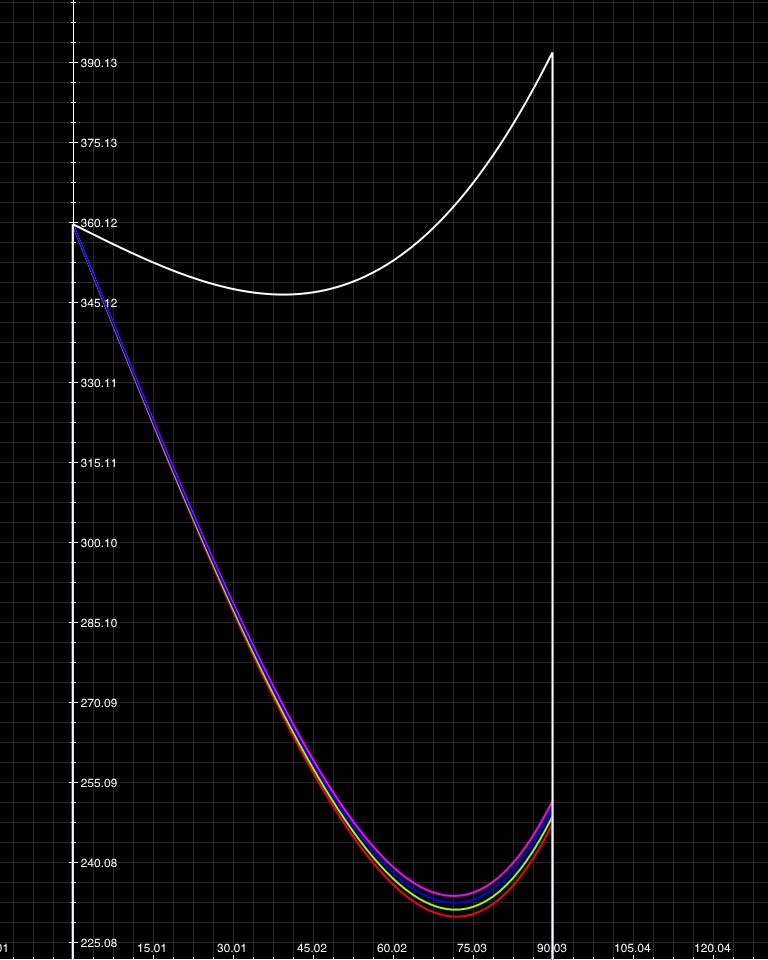
For two internal reflections you get the water-based secondary rainbow at 230° (so you'll see it in a 50° arc around the usual 40° rainbow) and the diamond-based secondary rainbow at around 350°. So the secondary diamond rainbow will be very dim (two reflections) and will be in a 10° arc around the sun. This physicist declares it ignorable.
Three reflections? Sure!
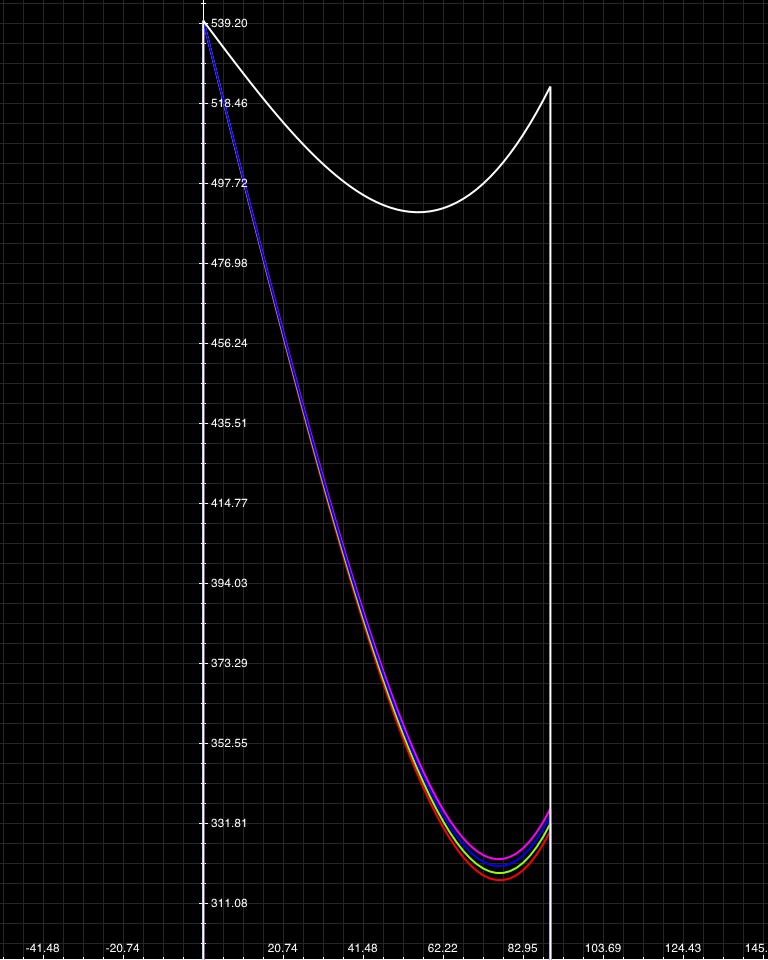
With three reflections you find that water creates a tertiary rainbow at 320° (40° around the sun), and diamond creates a tertiary rainbow at 490°, which would be a 50° arc opposite the sun.You've probably never noticed that third rainbow around the sun after a rain, because it's just too damn dim.
I got very stoked about this question. So for all you other backyard rainbow-and-math enthusiasts who want to figure out when and where rainbows will show up in different materials, here’s a list of some indeces of refraction, and the equation:
Where A is the turning angle, R is the number of reflections, ND is the index of refraction of the Droplets, and NS is the index of refraction of the Surrounding material. , again, isn’t terribly important. Graph it, look for a minimum, and figure out what angle in the sky that corresponds too.
By the way: did you know that Titan’s atmosphere is almost all nitrogen (N=1) and that it rains liquid methane (N=1.29)? Just saying.
I haven’t included anything about light intensity and reflection coefficients, but in general: three reflections is a bit much, and you can pretty much ignore what happens when is close to 90°.







Pingback: Q: If light slows down in different materials, then how can it be a universal speed? | Ask a Mathematician / Ask a Physicist
Awesome reply! It was very informative and, really, quite understandable.
Thank You for taking your time to post this reply.
Pingback: Paris | Yep.
Pingback: Refraction Reflection Refraction | evsc